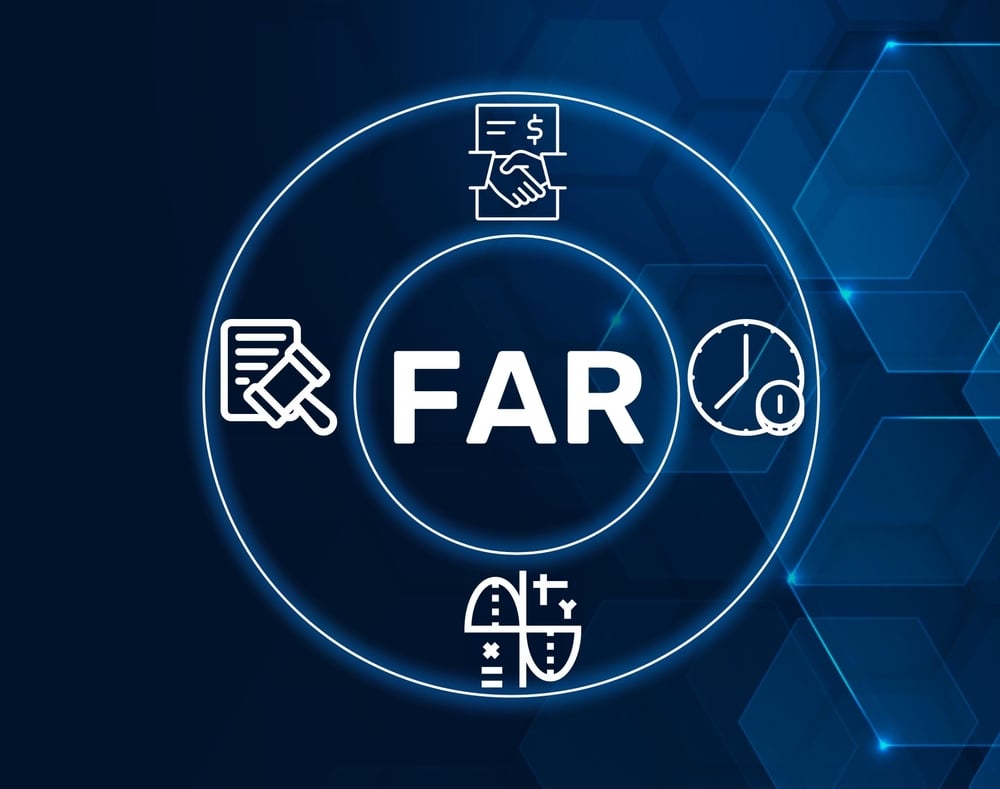Revolutionary FAR Overhaul: What Gov Cons Need to Know

Key Details: The Federal procurement landscape is set to undergo its most significant transformation in decades. Earlier in April, President Trump issued Executive Order (EO) 14275, titled “Restoring Common Sense to Federal Procurement.” This EO aimed to eliminate excessive acquisition regulations and to modernize the Federal Acquisition Regulation (FAR). This initiative is led by the Office of Federal Procurement Policy (OFPP) and the Federal Acquisition Regulatory Council (FAR Council) and is set to return the FAR to its statutory roots. Overall, the anticipated outcome of this streamlining activity will be faster acquisitions, greater competition, and better results in Federal procurement.
On May 2, the U.S. government announced further steps in its overhaul plan and established a Revolutionary FAR Overhaul (RFO) website on Acquisition.gov. This overhaul will impact every federal contractor. As such, businesses are encouraged to learn more about the changes and to contact their advisor to learn more.
Overview of Timeline
- April 2025: President Trump signs EO 14275, directing a comprehensive overhaul of the FAR to cut unnecessary regulations
- May 2025: draft revisions to key parts of the FAR were released (Parts 1, 34, and 52)
- June 2025: revisions to FAR Parts 1, 10, 11, 18, 34, 39, and 43 were posted on the RFO website
- Late 2025: ongoing revisions and formal rulemaking on a rolling basis
Background on the FAR
The FAR is the primary set of uniform policies and procedures governing how federal agencies acquire goods and services. It was established in 1984 to standardize procurement across civilian and defense agencies, promoting fair competition and ensuring the government obtains the best value while upholding public policy objectives. The FAR is maintained by the FAR Council and is supplemented by agency-specific regulations. Over time, the FAR has expanded to 53 Parts, reflecting statutory mandates and policy add-ons.
Background on the Overhaul
Executive Order 14275, titled “Restoring Common Sense to Federal Procurement,” was issued on April 15, 2025, as the catalyst for a comprehensive FAR reform. The Executive Order was motivated by concerns that the burgeoning volume of acquisition regulations led to inefficient use of taxpayer dollars and unnecessary bureaucracy. The EO established a clear policy that the FAR should “contain only provisions that are required by statute or that are otherwise necessary to support simplicity and usability, strengthen the efficacy of the procurement system, or protect economic or national security interests.” In effect, any requirements not grounded in law or essential mission needs are deemed excess and targeted for removal.
Moreover, the directive calls for pruning redundant policies at every level (including agency-specific regulations) to eliminate over-regulation. To carry out this mandate, the Office of Federal Procurement Policy (OFPP) within OMB, in coordination with the FAR Council agencies (DoD, GSA, and NASA), launched what is being called the “Revolutionary FAR Overhaul (RFO).” The RFO is a phased initiative to refocus the FAR on its statutory roots and replace much of the deleted regulatory content with alternative guidance tools. Rather than simply discarding useful practices, the plan calls for developing “Strategic Acquisition Guidance (SAG)”—a suite of plain-language playbooks and reference guides to capture best practices, innovative techniques, and category-specific strategies outside of the official FAR text.
Another noteworthy aspect of this overhaul effort is speed and approach. Federal agencies have been directed to implement the draft FAR changes immediately via class deviations, even before formal rulemaking is completed. GSA and other agencies began issuing deviation memoranda in May–June 2025 to align their solicitations and contracts with the revised FAR language.
Some Changes So Far Under the Overhaul
Although the FAR overhaul is ongoing (with new draft parts released for feedback on a rolling basis), several significant changes and themes have already emerged from the parts revised to date. Overall, the RFO changes aim to enhance clarity, speed, and relevance in acquisition by eliminating unnecessary text and emphasizing core principles. Crucially, no statutory requirements are being removed. Key legal mandates like competition rules, small business preferences, and fiscal law constraints remain firmly in place, but many agency-imposed procedures and boilerplate policies are being pruned or relocated to guidance documents.
FAR Part 1 – General
A new provision will cause any FAR section not required by law to automatically expire after 4 years unless renewed by the FAR Council. Part 1 revisions also trimmed lengthy “guidance” paragraphs.
FAR Part 11 – Describing Agency Needs
The overhaul of FAR Part 11 removed many prescriptive requirements for how agencies specify product/service needs. Mandates for "brand-name or equal" product descriptions and rigid delivery schedule rules were removed. In their place, Part 11 now encourages robust market research and the use of commercial products and services.
FAR Part 18 – Emergency Acquisitions
FAR Part 18, which governs emergency and crisis procurement, was condensed. Redundant details and non-regulatory guidance references were removed from the FAR. General acquisition flexibility and guidance were also removed and are now located in a separate emergency procurement section of Acquisition.gov. This update highlights the need to remain flexible when emergencies arise.
FAR Part 39 – Acquisition of Information and Communication Technology
FAR Part 39 was retitled “Acquisition of Information and Communication Technology (ICT)” and updated to reflect current tech priorities. The revised Part 39 highlights considerations for cybersecurity, cloud services, Internet of Things (IoT) devices, and artificial intelligence in federal contracts. It reinforces the use of modular contracting methods and retains key requirements like accessibility standards, but deletes obsolete references and eliminates duplicative clauses.
FAR Part 43 – Contract Modifications
FAR Part 43 was reorganized to focus on the essentials of contract modification, shedding some repetitive text. The core processes for change orders, supplemental agreements, and administrative modifications remain, but extraneous guidance was pared back to reduce bureaucratic friction.
Conclusion and Next Steps
Stay Informed on Overhaul Developments
Regularly check the Revolutionary FAR Overhaul page on Acquisition.gov for newly released draft FAR parts, deviation guidance, and FAQs. The FAR Council’s RFO website is the central hub for overhaul materials, including “Practitioner Albums” for each updated part. Subscribe to newsletters and follow industry commentary to stay ahead of changes.
Review and Adjust Contracts & Compliance
Assess your federal contracts and proposals in light of the streamlined FAR parts. Determine if any newly eliminated requirements or added flexibility could be beneficial. Agencies may incorporate deviations into solicitations and existing contracts. Update compliance checklists and training materials accordingly.
Adapt Strategies and Engage Early
Contractors should be ready to engage early in the procurement process to understand agency-specific deviation implementations. Prepare for inconsistencies during the transition and maintain open communication with contracting officers through Q&A or pre-proposal conferences.
Additional Action Items to Consider
- Designate someone in your contracts or compliance team to track developments weekly
- Be prepared to embrace agility in internal processes
- Review your proposal development process and streamline where possible
- Update internal policies to align with the new FAR
- Train staff on the need for flexibility
- Tailor proposals to highlight flexibility and value
- Reevaluate pricing and cost assumptions in light of reduced compliance costs
- Monitor the labor market and prepare to scale teams quickly if needed
The Revolutionary FAR Overhaul is poised to fundamentally update how federal contracts are written and executed. To stay ahead, government contractors are encouraged to understand the overhaul's background and objectives. For further information, contact Ryan & Wetmore today.
Today’s Thought Leaders

About Peter Ryan
Partner, Co-founder, & CPA
Peter T. Ryan co-founded Ryan & Wetmore in 1988 with business partner Michael J. Wetmore. Peter provides clients with the best strategies for success. His expertise extends across various industries. Peter holds an MBA in Finance from the University of Baltimore and a BA in Accounting from the Catholic University of America.

About Rosie Cheng
Finance Consultant
Rosie Cheng is a Finance Consultant at Ryan & Wetmore. She focuses on government contracting services and produces many of the firm’s government contracting newsletters. Rosie earned her Master of Science in Management from Georgetown University and a BBA from William and Mary.


